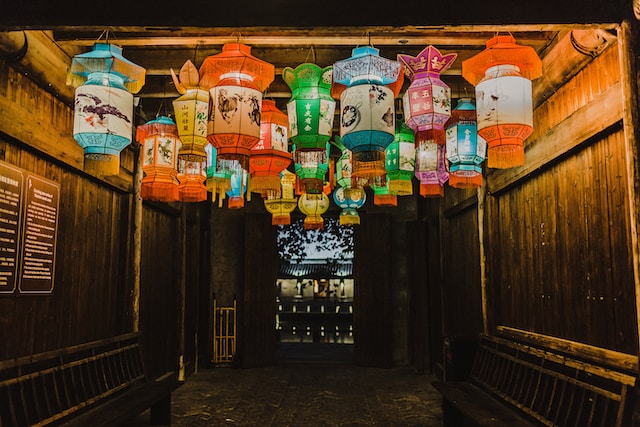Tradition refers to customs and beliefs that have been passed down from generation to generation within a specific community or family. Culture, on the other hand, encompasses the broader characteristics of a society including language, art, music, food and social norms.
What is tradition?
(Photo by Vlad Vasnetsov)

Tradition is a set of customs and beliefs that have been passed down from one generation to another. These practices can be related to religion, family, or community. Traditions help people connect with their roots and preserve their cultural heritage. They are timeless and often carry deep emotional significance for those who follow them.
Traditions can take many forms such as holidays, rituals, ceremonies, stories, songs, dances or even food preparation methods. For example, Christmas traditions include decorating a tree on December 25th and exchanging gifts while Ramadan traditions involve fasting during daylight hours for the entire month.
Traditions also serve as a way of maintaining social cohesion by providing common ground among disparate groups within society. By participating in shared traditions together year after year, people develop a sense of unity that helps build stronger communities.
While some traditions may seem outdated or irrelevant today due to changes in societal norms or advancements in technology; they still hold great value for those who practice them as they provide comfort and familiarity amidst an ever-changing world.
What is culture?
(Photo by bhupesh pal on Unsplash )

Culture is a term that encompasses the beliefs, customs, practices, and social behavior of a particular group of people. It can refer to everything from art and literature to religion and politics. Culture is not static; it evolves over time as society changes.
One aspect of culture is language. Each culture has its own unique language or dialects that are spoken by its members. Language plays an essential role in shaping cultural identity and helps people maintain their traditions and values.
Another important aspect of culture is cuisine. Food serves as both a source of sustenance and social bonding for many cultures around the world. Different cultures have their own cooking techniques, ingredients, flavors, and dishes that reflect their history and geography.
Music also plays a significant role in cultural expression. Music represents the shared experience of a community or society through rhythm, melody, lyrics, instrumentation or dance movements.
Finally yet importantly: Architecture reflects different aspects such as climate conditions or artistic preferences which translate into iconic landmarks recognized worldwide representing each country’s particularities; hence contributing to national heritage preservation while remaining modernized with contemporary trends
Tradition Vs. Culture – Key differences
While tradition and culture are often used interchangeably, they actually have distinct meanings. Tradition refers to customs or beliefs that have been passed down through generations, while culture encompasses a broader range of elements including language, art, music and food.
One key difference between the two is that traditions tend to be more specific and localized. They may involve certain rituals or practices that are unique to a particular community or family. Culture however can vary widely across regions and even countries.
Another important distinction is that traditions typically focus on preserving the past and maintaining continuity with previous generations. In contrast, culture is constantly evolving and adapting to new influences from other societies.
While both tradition and culture play an important role in shaping our identities, it’s crucial not to conflate the two concepts. Understanding these differences can help us appreciate the richness of human diversity around the world.
Examples of tradition
Traditions are practices and customs that are passed down from generation to generation. They may have religious, cultural, or social significance. Here are some examples of traditions around the world.
In Japan, it is a tradition to take off your shoes before entering a home or certain buildings like schools and temples. This symbolizes respect for cleanliness and hygiene in Japanese culture.
In India, the festival of Diwali celebrates the victory of light over darkness and good over evil. It is celebrated with lights, fireworks, sweets, and exchanging gifts among family members.
In Mexico, Dia de Los Muertos or Day of the Dead is a tradition where families gather together to remember their loved ones who have passed away by creating altars decorated with flowers, candles and food offerings.
The Scottish Highland Games celebrate traditional sports such as caber tossing (throwing large poles), tug-of-war competitions between clans known as “tugs o’ war” ,and bagpipe competitions which were once used by warriors in battlefields.
These are just a few examples of how traditions can vary greatly across different parts of the world!
Examples of culture
Culture can take on many forms, and it’s often unique to specific regions or groups of people. One example of culture is cuisine – the foods that a group enjoys and creates. For instance, Mexican culture includes dishes like tacos and guacamole, while Italian culture features pizza and pasta.
Art is another aspect of culture that differs depending on where you go in the world. In Japan, traditional art forms include calligraphy and ikebana (the art of flower arrangement), while Western cultures typically emphasize painting, sculpture, and photography.
Music also plays a significant role in cultural expression around the globe. African music often incorporates drums and other percussion instruments for rhythm, whereas classical Indian music showcases complex melodies created with stringed instruments like the sitar.
Language is perhaps one of the most obvious examples of cultural differences between communities. From idiomatic expressions to slang terms exclusive to certain areas or demographics, language reflects a particular way of life unique to its speakers.
There are countless examples of how different cultures express themselves through food, art , music ,language which contribute towards making each region distinct from one another .
What are the types of culture?

Culture is a complex and diverse concept that encompasses various aspects of human life. There are several types of culture, each with its unique characteristics and features.
One type of culture is material culture, which refers to the physical objects created by humans that reflect their beliefs, values, and practices. This includes things such as art, architecture, clothing, tools and technology.
Another type of culture is language culture which involves the way people communicate with one another through spoken or written words. It includes dialects or regional variations in language use along with accents.
Social Culture relates to social norms and expectations within a society such as gender roles or family systems. Social behavior including greetings , gestures also fall under this category
Aesthetic Culture comprises artistic expressions like music, dance forms etc..
Cultural Culture often referred to as intangible cultural heritage (ICH) – this can include folklore storytelling traditions passed down from generation to generation or rituals performed during religious ceremonies.
Each form of cultural expression has an important role in shaping how we view ourselves individually & how we operate collectively within societies across the world.
What are the types of traditions?
Traditions are an integral part of our lives, and they vary from region to region. Different cultures have different traditions that distinguish them from each other. Here are some common types of traditions:
Religious Traditions: These traditions revolve around religious beliefs and practices such as the celebration of festivals, pilgrimage, prayer rituals etc.
Social Traditions: These are customs or practices within a society that have been passed down through generations. Examples include marriage ceremonies, family gatherings on special occasions like birthdays and anniversaries.
Culinary Traditions: Food is an essential aspect of culture and tradition. Every country has its unique cuisine with traditional dishes prepared in a certain way using specific ingredients.
Artistic Traditions: Art plays a vital role in preserving cultural heritage. From music to dance forms to paintings, every art form has its own set of traditions that define it.
Folklore Traditions: Folk tales, myths & legends form a significant part of many cultures worldwide; these stories help people connect with their roots by passing on moral values and lessons learned from ancestors.
Traditions hold immense significance for communities worldwide; they strengthen social bonds while also helping individuals understand their place in society better.
Featured Image By – Alexander Grey on Unsplash









